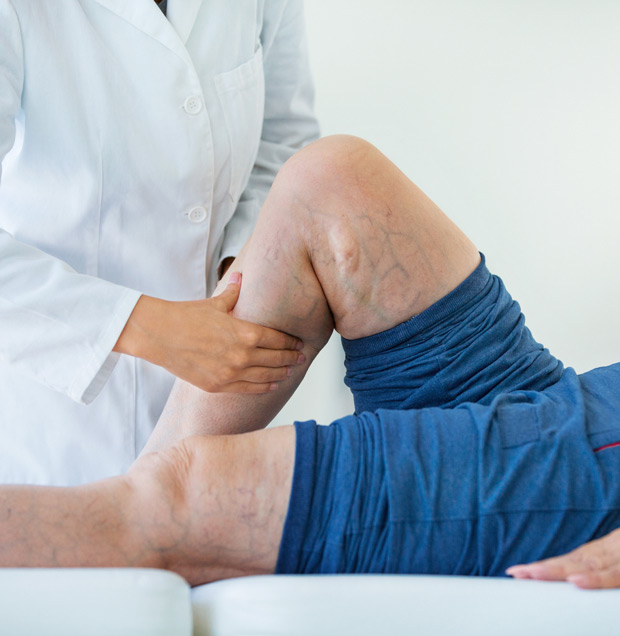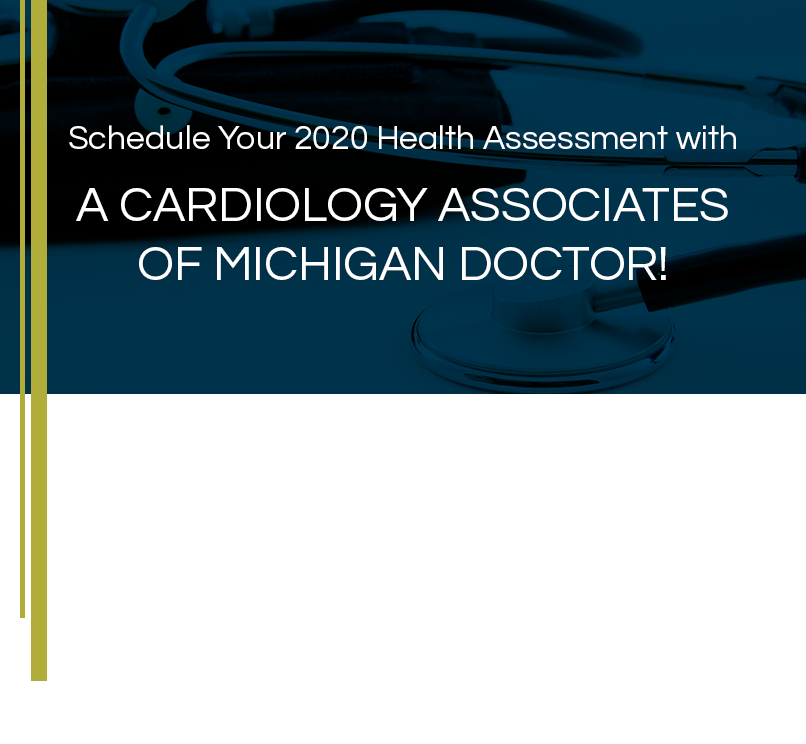
Venous
Troublesome, painful varicose veins can be signs of serious heart-related conditions. Poor circulation in the legs, arms, and other areas of your body are indicators that you may need to make an appointment to see a cardiologist, and some types of blood clots due to varicose veins or poor circulation may require immediate care.
Learn more about specific heart conditions and treatments below.
Varicose Veins
Varicose veins are often thought of as a cosmetic problem, but for many people varicose veins and chronic venous insufficiency can cause other issues.
Symptoms include:
- legs feeling heavy or tired
- aching legs
- fatigue
- swelling (rings formed by the sock)
- restless legs
- Itching
The symptoms can get worse after standing a long time or at the end of the day. Discoloration — a dark or bronze skin color — extending from the mid-calf down to the ankles can occur.
Over time, the constant pressure on the vein walls from weakened valves, or venous insufficiency, can lead to more inflammation, persistent swelling, further discoloration, and leathery skin. In the most severe or advanced cases, ulcers may form at or above the ankles.
Some people with this condition are able to find relief by raising their legs or with lifestyle changes (avoiding long periods of standing, losing weight, and walking). Others get relief by wearing compression stockings or compression sleeves. More advanced stages and symptoms require treatments that identify the veins that aren’t working and “closing or removing them” using a variety of techniques.
Many people over the age of 60 have some form of varicose veins. The disease may start at a very early age. Varicose veins are more common in women, but many men have them, too. Quite a few factors can lead to chronic venous insufficiency. The biggest risk factor is family history, or an inherited weakness in vein walls.
Other risk factors include hormones (such as progesterone), pregnancy, smoking, and obesity. Women who have had more than one pregnancy are at greater risk. Varicose veins can become worse during the late part of the menstrual cycle. They also may occur after a blood clot (deep vein thrombosis) in the leg. Proper function of the venous system involves the muscles of the legs to assist in “pumping” the blood back up toward the heart. This places at much higher risk those with jobs that involve long hours standing or sitting, and individuals on bedrest who don’t move their legs.
You should call a doctor if your legs feel heavy or tired, or if you have symptoms. If you develop areas of redness or tenderness, pain when walking, a sudden increase in swelling, sores, or if your symptoms begin to affect your lifestyle, you should call a health care professional. These are all signs of advancing venous insufficiency or complications from the condition.
Inflammation or redness may be due to an inflammation of the vein (thrombophlebitis). Swelling and tenderness may be a sign of a blood clot (deep vein thrombosis). However, it is rare for varicose veins to cause a serious blood clot.
Your health care professional will take a complete medical history and examine you.
He or she likely will order a special leg ultrasound called a venous reflux study. This test takes about 45-60 minutes to perform. It is usually done with the patient lying down with head tilted up or with the patient standing. A detailed test will attempt to rule out blood clots (deep vein thrombosis) and assess valve function. A blood pressure cuff may be placed around the leg.
Sometimes, more detailed testing is required, in particular if there is a history of blood clot. A CT scan may be recommended to look for venous blood flow obstruction that slows the upward flow of blood.
There is no clear way to prevent varicose veins from forming. Staying lean and remaining active are recommended. Avoid prolonged sitting or standing. If needed, use compression hose to minimize lower extremity congestion.
Compression hose may be obtained over the counter, but for more severe disease, graduated compression hose with prescription strength compression may be recommended. Many sports stores are selling compression sleeves which may also provide similar benefit.
Compression stockings come in various types, strengths, and lengths. They can provide relief from some of the symptoms but do not cure varicose veins. People with so-called venous ulcer disease should wear compression stockings. This form of treatment is typically the first line of therapy. They may be difficult to apply and often require direction for proper fitting.
Other forms of compression include wraps that stay on for several days and have a medication to help skin or ulcers heal. Pneumatic compression devices also may be recommended for excessive swelling and a progressive form of venous insufficiency. This therapy consists of pumps that are worn on the legs intermittently for hours a day.
An effective way to treat varicose veins and chronic venous insufficiency is a procedure in which the failing veins are closed or removed. This can be done only for the superficial veins.
A number of minimally invasive procedures with less discomfort and downtime are available to seal closed the “broken” (dysfunctional) veins and allow the blood to be rerouted through healthy veins. These methods include thermal ablation, mechanochemical ablation, sclerotherapy, and glue. These procedures are typically performed in a medical office or clinic with local anesthetic and take less than an hour.
Thermal ablation procedures are very common. With this technique, the tissue around the vein is anesthetized, or numbed, by injection of medication. Then a catheter is inserted into the leaking vein and the vein wall is sealed closed using the energy produced by heat (laser or radiofrequency).
Other techniques available include mechanochemical ablation or glue, in which the vein is closed without needing to use heat. These procedures do not require as much local anesthetic and are usually less painful. Varicose vein clusters can be injected with a special medicine to chemically destroy them (sclerotherapy) or can be removed with tiny surgical hooks and local anesthetic (phlebectomy).
When a varicose vein is treated, or shut down and sealed closed, the blood is rerouted via healthy veins with working valves. The same blood that used to collect in the lower leg causing swelling is now able to flow properly.
Varicose veins are very common and do not bother most people. In those cases, there is no need for concern. Over time, symptoms can occur such as aching and swelling. If the symptoms become bothersome, then a specialist evaluation is recommended.
Superficial and Deep Vein Thrombophlebitis
Deep vein thrombosis (DVT) is a blood clot (thrombus) in a deep vein, usually in the legs.Clots can form in superficial veins and in deep veins. Blood clots with inflammation in superficial veins (called superficial thrombophlebitis or phlebitis) rarely cause serious problems.
A superficial venous thrombosis is a blood clot in a vein that is close to the surface of the skin. A superficial thrombosis usually forms a firm lump, sometimes like a rope, under the skin. Often the skin is red and tender. The skin may look infected, but an actual infection is not common. If the area around the clot has inflammation, it is called superficial thrombophlebitis, or simply phlebitis.
Blood clots in superficial veins usually are not serious. Home treatment is typically all that is needed unless the clots are very painful or uncomfortable.
But clots in deep veins (deep vein thrombosis) require immediate medical care.Deep veins are the veins that are near the bones and surrounded by muscle. These veins lie deeper under the skin and return more blood to the heart than surface (superficial) veins.
These clots are dangerous because they can break loose, travel through the bloodstream to the lungs, and block blood flow in the lungs (pulmonary embolism). Pulmonary embolism is often life-threatening. DVT can also lead to long-lasting problems. DVT may damage the vein and cause the leg to ache, swell, and change color.
Blood clots most often form in the calf and thigh veins, and less often in the arm veins or pelvic veins. This topic focuses on blood clots in the deep veins of the legs, but diagnosis and treatment of DVT in other parts of the body are similar.
Each year in the United States, between 350,000 and 600,000 people get a blood clot in the legs or in the lungs.
Blood clots can form in veins when you are inactive. For example, clots can form if you are paralyzed or bedridden or must sit while on a long flight or car trip. Surgery or an injury can damage your blood vessels and cause a clot to form. Cancer can also cause DVT. Some people have blood that clots too easily, a problem that may run in families.
Symptoms of DVT include swelling of the affected leg. Also, the leg may feel warm and look redder than the other leg. The calf or thigh may ache or feel tender when you touch or squeeze it or when you stand or move. Pain may get worse and last longer or become constant. If a blood clot is small, it may not cause symptoms. In some cases, pulmonary embolism is the first sign that you have DVT.
If your doctor suspects that you have DVT, you probably will have an ultrasound test to measure the blood flow through your veins and help find any clots that might be blocking the flow. Other tests, such as a venogram, are sometimes used if ultrasound results are unclear. A venogram is an X-ray test that takes pictures of the blood flow through the veins.
Treatment begins right away to reduce the chance that the blood clot will grow or that a piece of the clot might break loose and flow to your lungs.
Treatment for DVT usually involves taking blood thinners (anticoagulants) for at least 3 months to prevent existing clots from growing.
Your doctor also may recommend that you prop up or elevate your leg when possible, take walks, and wear compression stockings. These measures may help reduce the pain and swelling that can happen with DVT.
There are things you can do to prevent DVT. After surgery, you can take an anticoagulant medicine to prevent blood clots. You might also wear compression stockings. You can try to get up and out of bed as soon as possible after an illness or surgery. If you are sitting for a long time, like during a long flight, you can exercise your legs to help blood flow.



